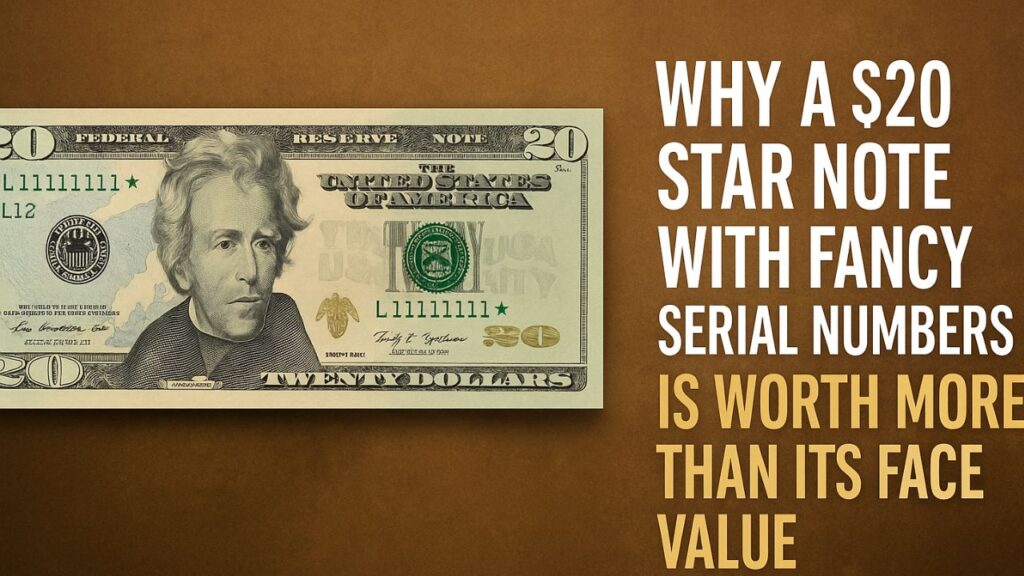A $20 star note with fancy serial numbers is more than just a piece of currency; it’s a collectible item that can fetch a premium price among enthusiasts and collectors. Understanding the factors that contribute to its value can help you determine if your note is worth more than its face value.
What Is a Star Note?
A star note is a replacement bill issued by the U.S. Bureau of Engraving and Printing (BEP) to replace damaged or misprinted currency during the production process.
Instead of a letter at the end of the serial number, star notes have an asterisk (*) to denote their status as replacements. These notes are typically produced in smaller quantities, making them rarer than regular bills.
Factors That Increase the Value of a $20 Star Note
1. Low Print Run
The rarity of a star note is significantly influenced by the size of its print run. Notes from smaller print runs are less common and more desirable to collectors. For instance, a print run of 640,000 notes or fewer is often considered rare and can command a premium over face value.
2. Fancy Serial Numbers
Serial numbers that exhibit unique patterns or sequences are highly sought after. Examples include:
- Low Serial Numbers: Such as “00000001*”
- Repeating Digits: For example, “77777777*”
- Ladder Patterns: Like “12345678*”
- Radar Patterns: Such as “87654321*”
These patterns are considered “fancy serial numbers” and can significantly increase a note’s value.
3. Condition of the Note
The physical condition of the bill plays a crucial role in its valuation. Notes in uncirculated or near-mint condition are more valuable than those showing signs of wear and tear.
Grading services assign a numerical value to the condition, with higher numbers indicating better quality.
4. Historical Significance
Older star notes or those from specific series may have historical significance that adds to their value. For example, a Series 1934-A $20 star note from Chicago can be more valuable due to its age and limited availability.
Estimated Value Ranges for $20 Star Notes
| Serial Number Type | Estimated Value (Circulated) | Estimated Value (Uncirculated) |
|---|---|---|
| Low Serial Number | $30 – $75 | $100 – $300 |
| Repeating Digits | $50 – $150 | $200 – $500 |
| Ladder Pattern | $100 – $300 | $500 – $1,000 |
| Radar Pattern | $150 – $400 | $600 – $1,500 |
| True Trinary Pattern | $200 – $500 | $800 – $2,000 |
Note: Values are approximate and can vary based on market demand and the specific characteristics of the note.
How to Determine If Your $20 Star Note Is Valuable
- Examine the Serial Number: Look for patterns or sequences that qualify as fancy serial numbers.
- Check the Print Run Size: Use resources like the Star Note Lookup tool to determine the print run size of your note.
- Assess the Condition: Evaluate the physical state of the note, considering factors like creases, folds, and discoloration.
- Consult Price Guides: Refer to reputable currency price guides to compare your note with similar ones in the market.
A $20 star note with fancy serial numbers can be worth more than its face value due to factors like rarity, unique serial patterns, and excellent condition.
Collectors are willing to pay a premium for these distinctive notes. If you possess such a note, it’s advisable to consult with a currency expert or utilize online resources to assess its value accurately.
Frequently Asked Questions
1: What makes a $20 star note with a fancy serial number valuable?
A $20 star note with a fancy serial number is valuable due to its rarity, unique serial patterns, and excellent condition, making it highly sought after by collectors.
2: How can I determine the print run size of my star note?
You can determine the print run size of your star note by using online tools like the Star Note Lookup, which provides information based on the note’s series and serial number.
3: Where can I sell my valuable $20 star note?
Valuable $20 star notes can be sold through reputable auction sites, currency dealers, or specialized numismatic marketplaces that cater to collectors.

